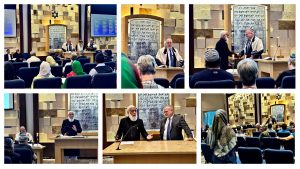It was an exceptional evening of friendship, learning, and prayer on Friday, August 9. About one hundred B’nai Tikvah members and members of Calgary’s Al Madina Islamic Assembly gathered at Temple to celebrate Shabbat with a potluck dinner and a prayer service. Each table was interfaith. Everyone talked and ate and talked some more. After that, Rabbi Mark Glickman led a service that included remarks by Imam Syed Soharwardy. At the end of the service, there was a Q&A where the Rabbi and Imam fielded questions about our faiths and world events.


view archived august 9 shabbat service
Then on Sunday, August 18, Rabbi Mark Glickman and members of Temple B’nai Tikvah joined Imam Syed Soharwardi and his congregation at the Al Madinah Calgary Islamic Assembly – the Green Dome Mosque. Visitors were greeted by the President of the Assembly, Malik Ashraf. The event included a question-and-answer session, plus time for socializing and a homemade lunch. The message was similar during both visits. The Rabbi and Imam both emphasized a need for building bridges between our two communities.

